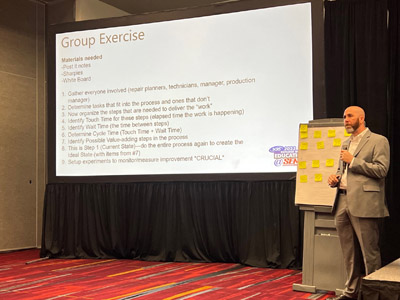Andrew Batenhorst says reducing the tasks assigned to estimators will improve a body shop's repair process as well as employees' work satisfaction.
The role of estimators in most auto body shops should die---but only because the duties currently expected of them should be divided into two categories, those of repair planners and those of customer service representatives.
Andrew Batenhorst, body shop manager at Pacific BMW Collision Center in Glendale, CA, delivered the reasoning behind his position during "The Death of the Estimator Role," one of many educational sessions offered at the 2023 SEMA Show as part of the Society of Collision Repair Specialists' (SCRS) Repairer Driven Education lineup.
"The estimator works closely with everyone in the shop and is really an 'assistant' shop manager," Batenhorst said. "There is a long list of tasks for a typical estimator, and most are, in my opinion, irrelevant to the role."
Batenhorst said his ideas on how to fix that problem might stress out a body shop manager initially, but they work.
In his vision, the "estimator" would split into two roles: a front office customer service representative (CSR) managing customer interactions, and a repair planner handling the technical aspects without customer engagement.
"Right now, an estimator spends 30% to 50% of their time doing CSR duties," Batenhorst said.
The first step is to take a hard look at the waste in a body shop's repair process.
Batenhorst recommended shop managers or owners try "value stream mapping"---tracking the series of steps that have to happen to provide the service their customers need, and then adding up the time needed to complete each step, as well as the wait time in between the steps. Then possible sources of waste can be identified, and an "ideal" process can be mapped out. The crucial final step is to set up experiments to monitor and measure improvement in the process in real time, Batenhorst said.
"It may seem strange to write it down and map it out like this, but it may reveal there are things your people are doing that you're not aware of," he said.
Batenhorst led attendees through an example exercise, writing down the steps in their repair planning process and the amount of time they estimated it takes---everything from gathering information and doing a vehicle walkaround with the customer, to disassembly, researching OEM repair procedures and checking parts availability.
He then shared the repair plan standards he wrote for his shop---documenting the steps of each task, who does it, when and how---and recommended posting those standards where everyone could see them. He also recommended getting employee input when writing them.
"You want to make sure the car flies through the shop without stopping," he said. "It's all setting a quality expectation."
Batenhorst said shop managers need to get out of the mindset of letting estimators "pick up all the pieces," as they're "really the surgeon of everything that's going on."
The ideal repair planner is naturally curious about the way the world works, emotionally in control, not afraid of confrontation, enjoys doing research, empathetic, has negotiation and collaboration skills and is not overwhelmed by fine detail work, Batenhorst said.
For necessary training, Batenhorst suggested "all of it."
"Send repair planners to the same training as master technicians, including painting," he said, acknowledging that it takes time, and takes them out of the production mix in the beginning.
To measure repair planners' success, set up three to four easy-to-measure key objectives, like sales mix and repair plan accuracy.
Also, set an authority limit---for instance, $5,000---under which the manager doesn't need to review the repair plan, and leaves it up to the planner.
Finally, go over regular progress reports with repair planners, either monthly or every three to six months.
Batenhorst said his suggestions can be scaled to any shop. The average repair planner can handle $250,000 to $300,000 in production every month. Shops that handle more than that would benefit from also hiring a repair planner assistant.
"In my shop, by implementing all these things, we have achieved a sales mix of 48% labor, 42% parts and 9% materials," Batenhorst said, noting that his shop only repairs BMWs, which often require expensive parts. He said his shop also achieved 82% repair plan accuracy in September, a gross profit on labor of 71% and paint materials of 68%.
"It all goes back to how we designed our process," he said.
Further, more clearly defining the role of repair planner has helped employees. Batenhorst said when he was hired to run the body shop, the lead repair planner was highly stressed. Now, he has a much better work-life balance because all of the excess was cut from his job duty list.
That increased job satisfaction leads to better repairs and reduced delays. Technicians also earn more money, so they want to stay with their employer.
"I implore all of you to take even just a fraction of what I've said today back with you," Batenhorst said. "The industry is plagued with so many issues. We have to trust in ourselves as leaders that we can make that change. If we want to attract new people to the industry, we can't keep doing things the same way."
Batenhorst then offered a list of resources, including signs.com to create process boards; Gemba Academy, an online resource to learn about lean theory; AkzoNobel's Acoat program; Paul Akers' YouTube channel; "The Toyota Way" by Jeffrey Liker; "The Five Dysfunctions of a Team" and "The Ideal Team Player" by Patrick Lencioni; and finally, himself---anyone can contact him at andrewb@pacificbmw.com or 818-691-2590.










Abby Andrews